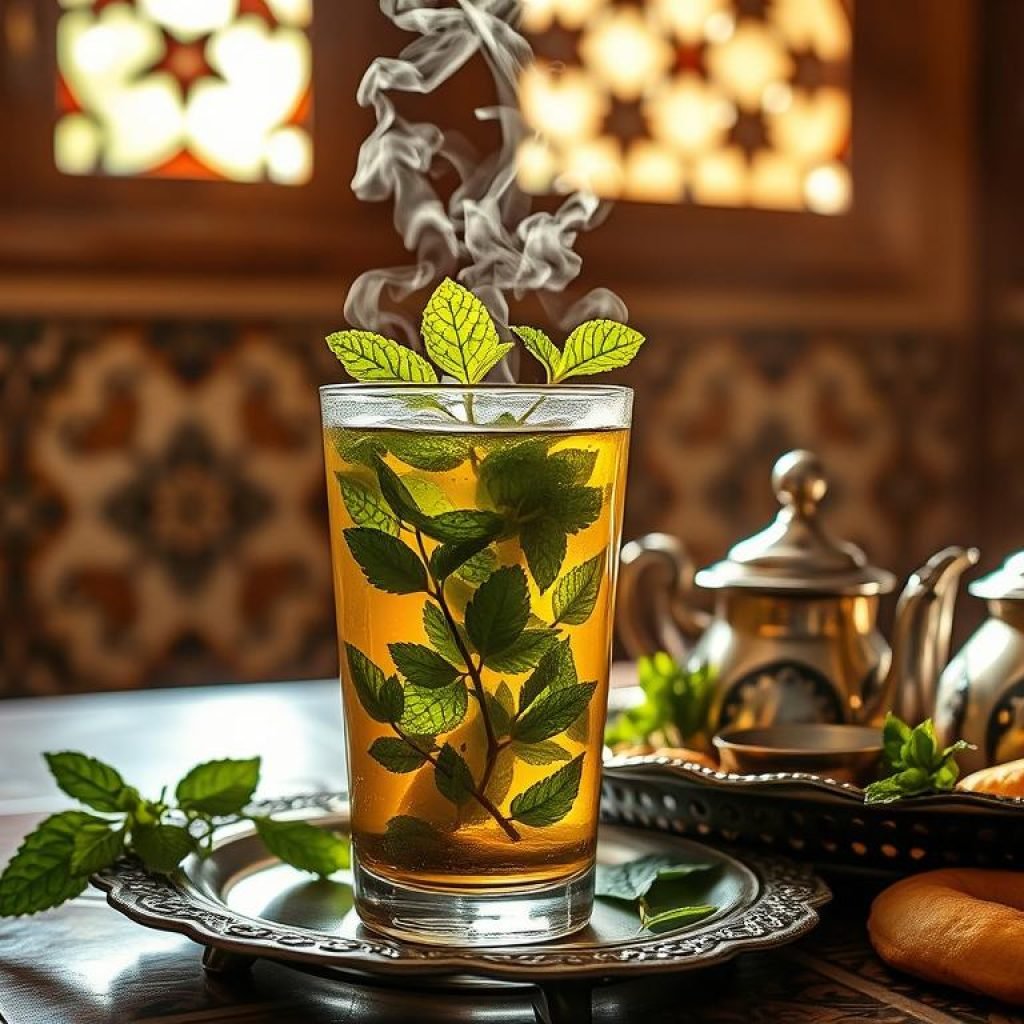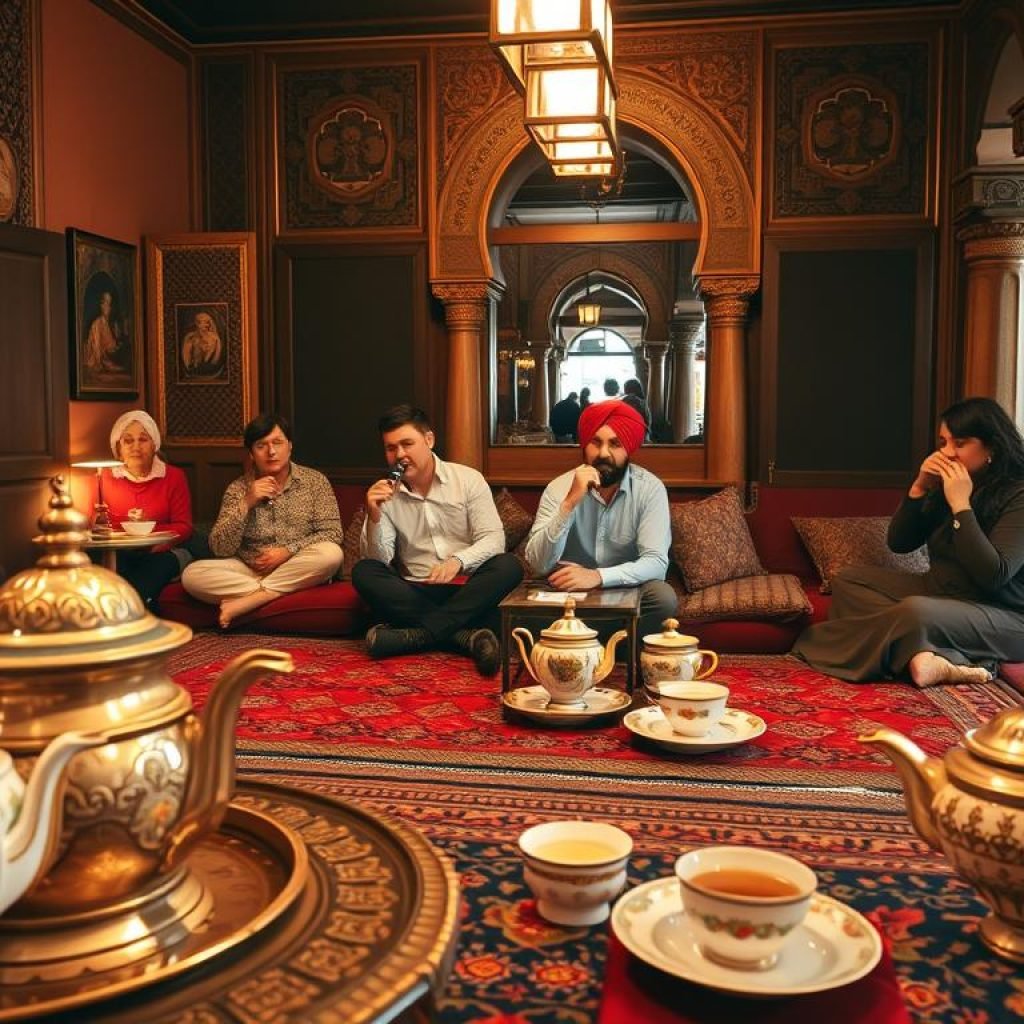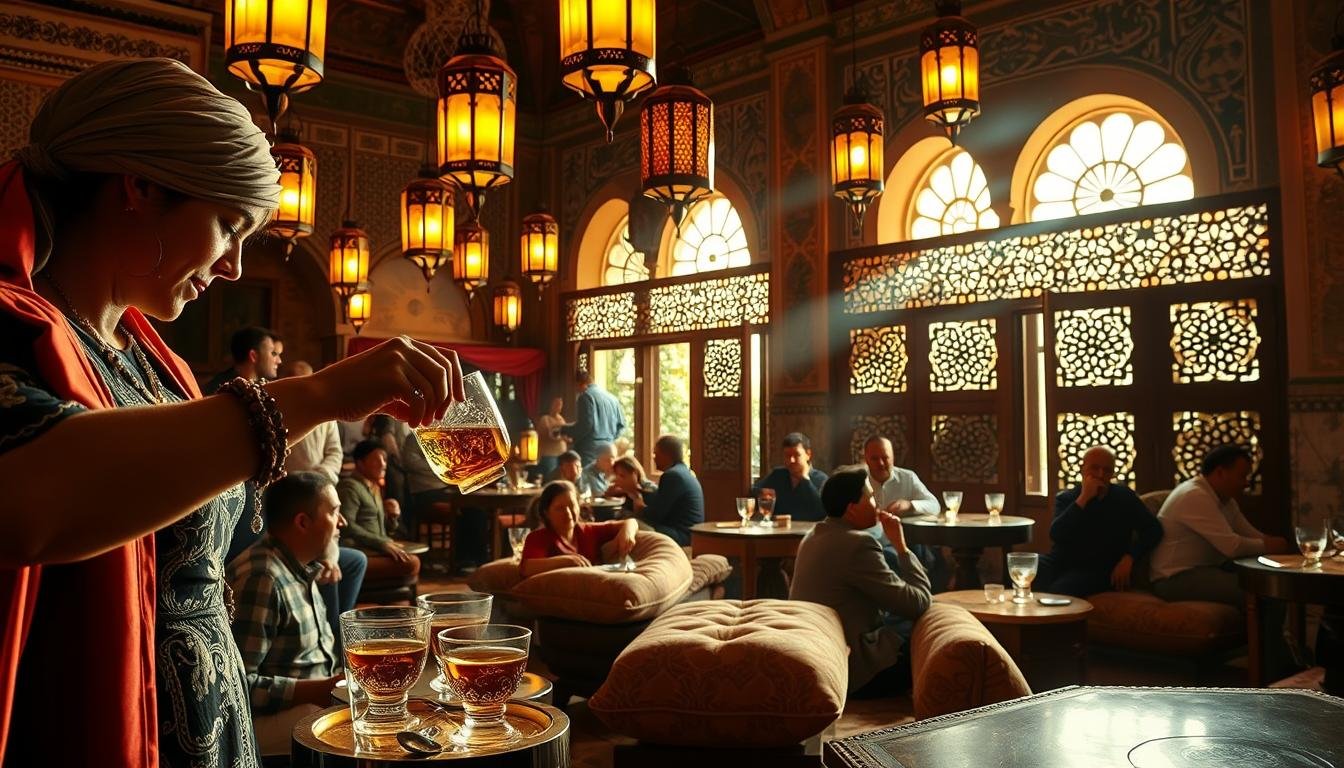What makes Moroccan tea culture so special? It’s the rich history and unique ways of making tea. Moroccan tea is key to the country’s hospitality and social norms. We’ll look into the importance of tea culture, how tea is made, and how Moroccan mint tea brings people together.
Moroccan tea has changed over time, shaped by things like gunpowder tea from the British in the 18th century. Now, about 90% of Moroccan homes have tea rituals. They make tea 3-4 times a day, showing how important tea is in their lives.
We’ll learn about Moroccan mint tea, how it’s made, and its role in social events. Its sweet and refreshing taste has made it famous worldwide. Moroccan mint tea’s cultural value goes beyond Morocco’s borders.
Key Takeaways
- Moroccan tea culture is a significant part of the country’s heritage, with a rich history and unique preparation methods.
- Approximately 90% of Moroccan households participate in tea rituals, emphasizing the cultural significance of Moroccan tea.
- Moroccan mint tea is a popular beverage, made with green tea leaves, fresh mint, and sugar, and is served in small glasses.
- The traditional tea preparation methods involve boiling water and pouring the tea from a height, which is considered an art form.
- Moroccan tea plays a vital role in social gatherings, with over 80% of interactions in shops including a tea offering, regardless of purchase intent.
- The average Moroccan tea recipe yields about 4-6 small cups, depending on the kettle size, and is often served with traditional pastries.
An Introduction to Moroccan Tea Culture
Moroccan tea culture is unique and fascinating. It’s at the heart of the country’s heritage. The traditional tea preparation method is key. It involves boiling water, adding green tea leaves, fresh mint, and sugar.
This process is more than just making a drink. It’s about creating an experience that shows Moroccan hospitality.
Tea is deeply rooted in Moroccan society. It was introduced by the British in the 18th century. By the mid-19th century, Moroccans loved it. Today, tea is a big part of Moroccan customs and ceremonies.
What Makes Moroccan Tea Unique?
Moroccan tea uses about two teaspoons of gunpowder Chinese green tea per half a liter of boiling water. The steeping time is at least 15 minutes. After adding sugar, the boiling process lasts 5-7 minutes to get the distinct taste.
The tea is poured from a height of at least half a meter. This creates froth, which is key to the tea ceremony.
The Symbolism of Tea in Moroccan Society
The traditional tea ceremony is a ritual that focuses on Moroccan hospitality. The tea is served in three rounds. The first is the strongest, the second milder, and the third the weakest.
This tradition is often accompanied by a saying. It highlights the characteristics of each serving: “The first glass is as bitter as life, the second glass is as strong as love, the third glass is as gentle as death.”
Types of Tea Served in Morocco
Moroccan tea culture is rich and full of history. It features many types of tea. Moroccan mint tea is a favorite, made with green tea and fresh mint. It’s a key part of Moroccan tea history and shows hospitality to guests.
Other teas like herbal infusions and specialty teas are also loved in Morocco. They’re valued for their health benefits and play a big role in Moroccan tea traditions. The traditional Moroccan tea ceremony, “Atay Naa Naa,” is a big part of their culture. It focuses on serving tea.

Key ingredients in Moroccan tea include green tea, fresh mint, and sugar. The tea is served in small glasses and is key at social events. Whether it’s a casual get-together or a formal ceremony, Moroccan tea is always at the heart of it.
Green Tea: The Foundation of Moroccan Tea
Green tea is the base of Moroccan tea, especially in Moroccan mint tea. The main tea used is Chinese green tea Special Gunpowder. It’s prized for its freshness and ability to quench thirst.
Herbal Infusions and Their Uses
Herbal infusions are also big in Morocco and are used for health reasons. These teas use different herbs and are a big part of Moroccan tea traditions. Favorites include peppermint, chamomile, and lemon balm.
The Art of Tea Preparation
Moroccan tea preparation is key in the tea ceremony, showing Moroccan hospitality. It’s a ritual that needs focus and traditional tools. In Morocco, tea is a big part of life, with people drinking about 1.22 kg each year.
The tea ceremony is a tradition that brings people together. It’s a sign of Moroccan hospitality, welcoming guests with tea flavored with spearmint. Preparing tea is detailed, using traditional teapots, glasses, and sugar bowls.
In a traditional Moroccan tea ceremony, the host uses special tools. The ceremony can last from 30 minutes to an hour. It involves serving several glasses of tea, with the first being mild and the last stronger.
Tools and Utensils Used in Making Moroccan Tea
Traditional tools for Moroccan tea include a teapot, tea glasses, and a sugar bowl. The teapot is often made of silver for practicality and to keep heat. Tea glasses are small, holding about 3 to 4 ounces, and are used for serving tea in multiple glasses.
Step-by-Step Guide to Brewing Moroccan Mint Tea
To make Moroccan mint tea, you need gunpowder green tea, fresh spearmint leaves, and sugar. Use about 2 large tablespoons of green tea for every liter of water and 7 tablespoons of sugar for a standard teapot. Mix the tea by pouring it high above the glass and back into the teapot several times to aerate it.
The Ritual of Tea Drinking
In Morocco, tea culture is a big part of social life. It’s deeply connected to the country’s history. Drinking tea is a key part of welcoming guests, enjoyed in social events and ceremonies.
Moroccan tea is always ready to drink, unlike in other Arab countries where it’s after meals. The traditional mix includes green tea, mint, and sugar. The head of the family serves it, pouring it high to make a frothy top.
Turning down tea is seen as rude. Guests are expected to finish all three cups of tea.
Here are some key aspects of the Moroccan tea ritual:
- Three servings of tea are always offered, reflecting the proverb: “The first glass is as bitter as life, the second is as strong as love, the third is as soothing as death.”
- Each serving of tea is designed to have a different flavor profile, with the first being strong and the last being soothing.
- The tea used is primarily Gunpowder green tea, which is known for its freshness and thirst-quenching properties.

In Morocco, tea culture is more than just drinking tea. It’s an art that shows respect and welcome. The special pouring method, called “la nâqua,” makes the tea even better by adding a frothy layer.
The tradition of making and serving tea in Morocco goes back centuries. It shows how important tea is in their culture.
Historical Context of Moroccan Tea Culture
Moroccan tea culture is rich and fascinating. Tea has been a big part of the country’s traditions since the 12th century. Green tea from China was first introduced then. Over time, Moroccan tea culture grew, adding local touches like fresh mint and sugar.
The story of mint tea in Morocco is a bit of a mystery. Some say it came from Phoenicians, others from Arabs or even Queen Victoria. But one thing is clear: mint tea is a big part of Moroccan tea culture. Moroccans drink it about five times a day. Making mint tea can take up to 30 minutes, showing the patience of men in this task.
Some interesting facts about Moroccan tea history and tea culture include:
- Morocco is one of the largest importers of tea in the world.
- Mint tea is traditionally consumed at any time of the day, with a preference for drinking it at the end of meals as a digestive.
- The ingredients for Moroccan mint tea include dried green tea, fresh mint leaves, large pieces of sugar, and boiling water.
In conclusion, tea history has deeply influenced Moroccan traditions. The mix of local ingredients and customs has made a unique tea culture. This culture is a key part of what makes Morocco special.
The Role of Tea in Social Gatherings
Tea is key in Moroccan social gatherings, helping people talk and bond. Moroccan hospitality is famous for being warm and inviting, and tea is a big part of it. When friends come over, they usually get a cup of tea as a sign of friendship and respect.
In Morocco, tea is more than just a drink. It’s a big part of tea traditions and tea culture. Making and serving tea is a group activity, where people share news, do business, or solve problems. Tea is present at all kinds of gatherings, from family get-togethers to big events like weddings and religious holidays. It shows unity and shared identity.
- Offering tea to guests as a sign of respect and hospitality
- The ritual of preparing and serving tea, which involves a high sugar content and a specific pouring technique
- The use of intricately designed tea sets, which reflect the country’s rich cultural heritage
In Morocco, tea is a big part of everyday life, more than just a drink. It shows Moroccan hospitality and the country’s tea traditions and tea culture. Whether it’s a small meeting or a big event, tea brings everyone together. It creates a sense of community and connection.
Celebrating Moroccan Tea in Festivals
Moroccan tea is a big part of the country’s tea culture. It’s celebrated in many festivals and events all year. These gatherings let people share tea and celebrate Morocco’s rich culture. For example, visitors can try Moroccan tea at Moroccan festivals and events.
In Morocco, Moroccan tea is key at social events and festivals. Making Moroccan mint tea is seen as a special act of warmth and welcome. Here are some important events and customs:
- Notable Events: Festivals like the Marrakech International Film Festival and the Fes Festival of World Sacred Music highlight Moroccan tea.
- Traditional Practices: The Moroccan tea ceremony, with its careful tea preparation and serving, is a big part of these festivals.
At these festivals, Moroccan tea is served with sweets like chebakia and ghriba. This makes the experience even better. Moroccan festivals are a great place to see the country’s culture and tea traditions up close.
The Influence of Moroccan Tea Culture on the World
Moroccan tea culture is spreading worldwide, bringing its unique traditions with it. The love for Moroccan mint tea has boosted green tea demand. China is the top exporter of green tea to Morocco, sending over 504,000 tons since 2017. This has added up to $1.56 billion in total value.
Cultural exchange has made Moroccan tea traditions popular globally. The use of fresh mint and sugar in Moroccan tea has become common worldwide. Many countries now prepare and serve tea in ways inspired by Morocco.
Several factors have made Moroccan tea culture popular worldwide. These include:
- The unique preparation method, which involves green tea, fresh mint, and sugar
- The cultural significance of tea in Moroccan society, highlighting hospitality and social bonding
- The adaptability of Moroccan tea traditions to different cultures and environments
Moroccan tea culture has also led to new tea trends and traditions. For example, herbal and fruit teas are now popular in Morocco. This has made the world’s tea culture more diverse and exciting.
Health Benefits of Drinking Moroccan Tea
Drinking Moroccan tea is not just tasty and refreshing. It also offers many health benefits. The tea is full of antioxidants. The fresh mint in it helps calm the mind and body.
Studies show that drinking 2 to 3 cups of green tea a day can help you live longer. The niacin in Moroccan mint tea may also lower bad cholesterol and raise good cholesterol. This makes it good for your heart.
If you’re curious about Moroccan tea culture, Morocco is a great place to visit. It offers romance, culture, and adventure. The country’s cities, landscapes, and history are all perfect for experiencing Moroccan tea culture.
Mint Tea and Its Refreshing Qualities
The mint in Moroccan mint tea has menthol, which helps with breathing problems. The L-theanine in the tea also helps you relax and can help with sleep. Plus, the tea has very little caffeine, so it’s good to drink before bed.
Antioxidants and Other Health Benefits
Some of the key health benefits of Moroccan tea include:
- Reducing psychological stress by up to 20% when consumed regularly
- Relieving digestive symptoms such as gas, bloating, constipation, and indigestion
- Neutralizing odors after eating malodorous foods due to its antimicrobial agents
- Alleviating cold or flu symptoms with its antiviral qualities
Tips for Enjoying Moroccan Tea at Home
To fully enjoy Moroccan tea, you need to know how to prepare it and its cultural importance. Moroccan tea culture centers on the art of tea making. It involves choosing the right ingredients and using traditional methods to make the perfect tea.
For Moroccan tea at home, you’ll need a few key ingredients. These are high-quality green tea leaves, fresh mint, and sugar. The tea should steep for at least 10 minutes to bring out the flavors. Pouring the tea from a height is a traditional method still used today.
When serving Moroccan tea, use ornate metal teapots and decorated glasses. These not only look good but also enhance the tea-drinking experience. It’s also common to keep topping up the tea during gatherings. This encourages more conversation and connection among guests.
For the ingredients, use one teaspoon of loose-leaf green tea for every 8 oz of water. Add a handful of fresh mint leaves and 2-3 tablespoons of sugar. You can adjust these amounts to your liking. The goal is to find a balance that you enjoy.
By following these tips, you can create a unique and memorable Moroccan tea experience at home. Whether you’re exploring Moroccan tea’s rich flavors or adding something special to your social gatherings, mastering the art of tea preparation is key.
Conclusion: The Enduring Legacy of Moroccan Tea Culture
As we wrap up our exploration of Moroccan tea culture, it’s evident that this tradition has stood strong for centuries. It started as a medicinal drink in the 18th century. Now, it’s a key part of Moroccan hospitality and social bonding, known as Moroccan tea.
The tea culture in Morocco has grown, showing the country’s rich history and diverse influences. The mix of Arab, Berber, and African traditions has made Moroccan tea traditions unique. Today, tea brings people together, creating a sense of unity among Moroccans.
In a world getting more connected, it’s crucial to keep traditional tea cultures alive, like Morocco’s. By cherishing the legacy of Moroccan tea, we help it stay a cherished tradition. It will continue to be enjoyed by people in Morocco and around the globe.




Comment (0)